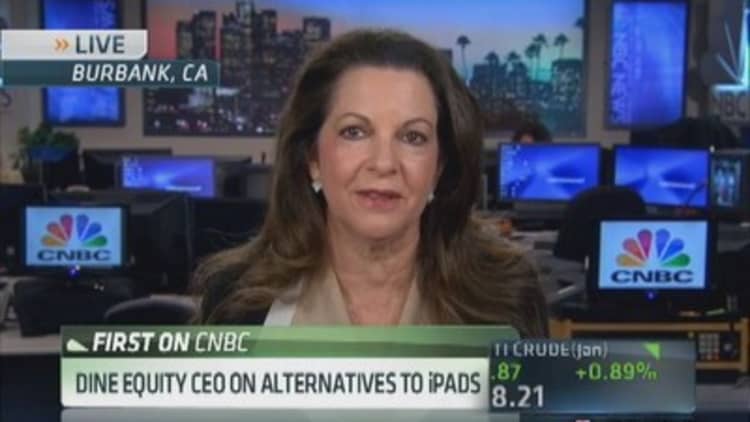We've all been there: You're ready to order or pay for the restaurant check, and your server is totally MIA. Suddenly what may only be an absence of a few minutes seems to stretch for an eternity.
To fix this problem, both restaurants and some start-ups are betting on the table-top tablet to place orders and pay the check—and even to keep yourself entertained.
But this new trend isn't all about customer convenience: These tablets are being touted as a way to boost check size at a time of sales stagnation in the restaurant industry.
In early December, Applebee's became the latest large restaurant chain to make the tablet leap. Buffalo Wild Wings is also testing tablets at some of its locations while Chili's plans to roll them out to hundreds of locations by next year.
(Read more: Tech to table? Applebee's set for big 2014 upgrade)
On Thursday, the U.S. Patent & Trademark Office published an application from Apple for a similar device for processing restaurant orders. The application noted that "traditional techniques, however, do have their shortcomings" since "ordering is completely dependent on the waiter's availability."

By the end of next year, Applebee's plans to install about 100,000 E la Carte Presto tablets, powered by Intel, at its more than 1,800 locations.
Its decision came following about two years of testing the concept, said Jay Johns, vice president of strategic operations implementation at DineEquity, which owns Applebee's. DineEquity-unit IHOP may also introduce the tablets in the future, Johns said.
(Read more: Chick-fil-A tests ordering app; national rollout may follow)
"Guest satisfaction improved when they used the device," Johns said. "The incidence of guests ordering appetizers improved and the service tips improved, which is a key point to us. We're not doing this to replace servers but to enhance the experience."
During the tests, average check size also improved and the tables turned more quickly.
If the company can duplicate these results in a nationwide launch, it could benefit sales, which have been lagging this year. During the first nine months of 2013, same-restaurant sales fell 0.1 percent, compared to the same period in 2012, reflecting a decline in traffic, partially offset by an increase in average check, according to DineEquity's most recent earnings report.
"Clearly, we think strategically that this will help drive traffic into the restaurants," Johns said. "In the business, the key is to drive traffic. You can't continually boost by pushing check size."
The move is also meant to attract millennials and to ease anxiety among customers who don't like giving their credit cards to servers.
"I think the millennial generation overall have come to expect technology," he said. "We think as those guests mature, have more money and visit our rest more, we have to be relevant to them."
Rajat Suri, E la Carte's founder and CEO, said the Applebee's deal was a game changer for his company, which currently has about 5,000 tablets in use.
After dropping out of Massachusetts Institute of Technology's Ph.D./MBA program, Suri founded the company in 2008, ahead Apple's release of the iPad, which helped tablets become mainstream.
(Read more: McFail: McDonald's out-of-touch tipping advice to employees)
"Restaurants have been around for thousands of years, and the basic experience hasn't changed," Suri said. "Now we have all this amazing software out there—why can't we apply it to restaurants?"
Since then, his company has attracted roughly $17.5 million in financing from several backers, including Intel Capital and Ron Conway. E la Carte charges restaurants a monthly fee for using the service and gets a slice of sales from the games and music that users play.
Applebee's announcement comes a few months after competitor Chili's Grill & Bar, which is owned by Brinker International, said it would rollout tabletop tablets from Ziosk to all of its company-owned restaurants by the first half of 2014.
Chili's has also seen domestic comparable restaurant sales skid. They fell 1.9 percent in its recently ended fiscal first quarter and 0.3 percent during the fourth quarter.
Like rival E la Carte, Ziosk also boasts strong results on its website from restaurants that use its tablets.
According to the company, appetizer sales rose 20 percent on average, while sales of desserts jumped 30 percent in restaurants that use the tablets compared to non-Ziosk restaurants. Tips and average per-person check size also increase.
Austen Mulinder, the company's president and CEO, found that about 70 percent of tables that have the tablets end up using them. Once restaurants sign up for the service, they pay a monthly fee but do not pay a percent of food or drink sales. They also get a share of sales of premium content, such as games and cartoons, which are meant to keep users entertained.
"The holy grail is making the guest come back more often," said Mulinder. "The thing that drives the most dollars for them is bringing customers back more often."
—By CNBC's Katie Little. Follow her on Twitter @KatieLittle.


